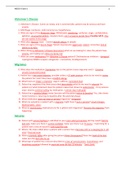MDCIV Exam 1 1 Alzheimer’s Disease 1. Alzheimer’s Disease: Comes on slowly, and is nonreversible, p atient may be anxious and have anxiety 2. Mild Stage: Confusion, mild memory loss, forgetfulness 3. What are signs of the Moderate Stage : Withdrawal, wandering , confusion, anger , confabulation, agitation, visuospatial deficits ,misplace items, can’t recognize people faces Possible SATA they are not violent in this stage 4. What does Agnosia mean - Cannot identify objects or people 5. What are signs of the Severe Stage : Patient may become aggressive , violent , nonverbal, lack of ability to do ADLs 6. When doing an Alzheimer’s Disease Assessment what are we looking for : does the patient have anxiety, and making sure ADLs are being met 7. What are some medications for Alzheimer’s Disease patient ? Cholinesterase Inhibitors - donepezil , rivastigmine NMDA receptor antagonists - memantine, Antidepressants Migraines 8. What does the medication Ergotamine due to the patient treats migraines and it - Constrict vessels! (vasoconst riction) 9. Patient has a new onset migraine , provider orders a CT with contrast , what do we need to assess the patient for? Ask if they have a shellfish allergy 10. What food can trigger a migraine - yogurt, caffeine, marinated food 11. Patient has migraines they been prescribed beta blocker what do we need to educate the patient on/ what statement does the patient makes that shows he understands - If my seizures stop I need to continue taking my medication, I cannot stop it abruptly . 12. Patient h as a postictal phase motor function will the patient return to baseline ? Yes, (the clients motor function is returning to baseline after the postictal phase) 13. What medication does not treat or prevent migraines? Verapamil 14. What are symptoms a patient with a migraine might have if aura is present ? visual changes, flashing lights, colors 15. What do maintenance medications do for a patient with migraines? Prevents the migraines from happening. Seizures 16. Patient with seizure /epilepsy is admitted to your room what precautions do they need? Pad the bed rails , make sure there is suction available , make sure there is an IV access – main thing for a patient with a seizure would to select pad the rails . 17. What is the state called when a pati ent with a seizure has a decrease LOC or is sleeping for 5 -30 mins ? Postictal state 18. How to promote safety after giving the patient Ativan (lorazepam)? Raise the head of the bed , make sure the bed rails are up 19. What type of patient has a seizure described a s a loss of consciousness , incontinence , and breathing cessation followed by postictal state the last 10 minutes - Tonic clonic MDCIV Exam 1 2 20. What medication do we give to the patient with seizures ? Ativan (lorazepam) 21. What is the priority when your patient is having a seizure ? Safety and getting them to their side 22. A patient is taking Dilantin for epilepsy can they stop taking that medication? No they can not stop taking it 23. A patient that is experiencing a tonic clonic seizure , will most likely always have a loss of consciousness 24. Generalized seizures involve both cerebral hemispheres ? – Yes 25. Phenytoin will be given when the seizure stops Parkinson’s 26. Patient with Parkinson’s and displaying slow movement ( dyskinesia ) patient states he know he needs extra time to complete activities - he understands his condition 27. What are symptoms of Parkinson’s ? Mask like face , muscle rigidity , hypokinesis (movement disorder) 28. When screening for Parkinson’s, what would you notice? Patient is shuffling , and proposal forward move ment 29. Patient is taking levodopa , what is that medication helping with? Muscle rigidity. 30. Cardinal signs of Parkinson’s? Tremors, Muscle Rigidity, Bradykinesia, Postural Instability 31. How to prevent respiratory complication in a Parkinson’s patient? Raise the head of the bed , purse lipped breathing Meningitis 32. What need to happen with a patient that has bacterial meningitis – the first simple measure to decrease ICP? Elevate bed 30 degrees 33. What type of precaution is the patient have with bacterial meningitis ? Droplet precaution 34. Viral meningitis does NOT have a high rate of fatality . 35. Living in close quarters are a cause for meningitis 36. Lumbar puncture - In this procedure, they’re sticking a needle into the spine to test for meningitis . 37. Clinical manifestations of meningitis - nuchal rigidity (stiff neck), positive Kernig’s, Brudzinski’s sign Dysreflexia (Spinal Cord Injury ) 38. Patient with paraplegic T6 -T7 – Priority autonomic dysreflexia – bowel and bladder 39. T6 or above spinal injury. They have excessively high blood pressure . Can cause bladder distention and impaction, muscle tone issues with bowel, bladder, and peripheral muscle. Sweat above injury and goosebumps below 40. Autonomic dysreflexia is a sudden , potentially life -threatening occurrence in patients with SCI 41. Intervention do NOT wear restrictive clothing 42. Priority assessment after spinal surgery - ABC Glasgow Coma scale (Neuro Assessment)




